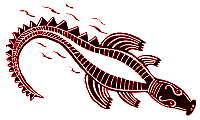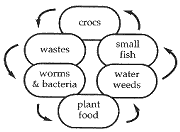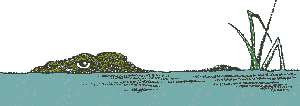| |
|
|
 An Education Kit
for Grades 5 - 7 An Education Kit
for Grades 5 - 7
|

|
| |
Activities for
teachers |
Summary |
|
KLAs |
| a Sublimely suited |
Identify and illustrate croc adaptations |
 |
English SoSE |
| b Food Webs |
Read and discuss text and illustration and construct food webs |
SoSE
Science |
| c Connections Chart |
Represent relationships between organisms in croc habitat on diagram |
SoSE
Science |
| d Making the connection |
Link related chains of connections discuss problems that occur when links are broken |
English
SoSE |
| Information Sheet Illustration and notes on tidal estuarine habitat, croc feeding and breeding behaviour, and feeding relationships between species in the same habitat. |
|
|
|
|
What you do
|
a) Sublimely suited
- Discuss with students the features that have made crocs such a successful reptile, a top predator. Refer back to Croc Features Information Sheet or to the report constructed as a class.
- Give each student a copy of the worksheet, Sublimely Suited.
Ask them to choose a croc feature, eg. eyes, nostrils or back legs, etc. and draw it onto the worksheet in the special feature column. Then ask them to note down how this feature might help the croc to survive.
- You can construct a large wall panel for display in the classroom.
|
|

|
|
b) Food webs
- As a class, discuss students' understanding of the terms 'prey' and 'predator' using some familiar examples, eg. fish/shark; grass/ wallaby, caterpillar/bird, etc.
- Extend the discussion to food chains where another link (predator or prey) is introduced,
eg. crab --> fish --> shark, grass --> wallaby --> snake, leaf --> caterpillar --> bird
Use arrows to indicate that the first is eaten by the second.
- In small groups or as a whole class, read the Croc Relationships Information Sheet. Ask students to describe the croc's habitat (the tidal river) and to identify the various animals and plants in the illustration. Discuss the feeding relationships present in the illustration, ie. who eats who?
- Working in small groups, ask students to construct a food web for the tidal river based on their understandings of feeding relationships. One way to make a food web is to arrange pictures or labels of organisms to form a food web. Photocopy and cut out labels from the Food Web worksheet and give copies to each group.
- A food web is an extension of the food chain and illustrates the many possible links between food chains. They can be simple or complex and demonstrate the inter-connectedness of organisms in a particular habitat. Here is an example of a simple food web:
|
|
|
c) Connections chart
- Discuss with students the relationships other than feeding that might exist between organisms in the tidal river, eg. mangroves provide shade for crocs, shelter for small fish and a home for pythons.
- Working individually or in small groups, ask students to draw a connections chart between elements in the tidal river such as shown to the right.
|
 |
- Ask students to write short explanations for each connection they have found. Encourage them to make several connections charts.
- Chains of connection allow the students to consider how animals and plants (and other elements) in the ecosystem are inter- connected in ways other than feeding. Arrows are used to link parts of the chain. Students must realise that the connections chart is not complete unit in itself but is connected to many others, eg. animals other than small fish feed on water weeds. In this way connection chains can be linked to each other.
|
d) Making the connection
- Ask the students to look closely at the different connection charts to see if whole chains can be connected to each other, eg. there may be several chains which contain crocs but which have different elements. Chains can be joined where there is a common element. This activity demonstrates how elements in a particular ecosystem are intricately dependent upon each other.
- Display the connections charts on the classroom wall or make a mural.
- Connections charts and food webs provide the basis for problem solving exercises. Set problems for students as a class or in groups such as 'During a flash flood, pesticide has run off from surrounding farms and has killed off many native water weeds. How will this affect the rest of the organisms in the tidal estuary?' or 'Developers plan to clear the mangroves for a golf course. How will this affect the organisms in the tidal river?'
Extension
- Play Food Web Chasey (see Additional Resources - Environmental Games) or similar games.
- Construct food chain mobiles. The croc template can be photocopied onto an OHP sheet, enlarged, and copied onto sheets of art paper. Make mirror images of the same illustration to give it two 'sides.' Students can paint both 'sides' of their crocs, stuff them with tissue paper and staple or glue together. Draw outlines of animals or plants at lower levels of the foodchain and repeat the process.
Make sure that students design their mobiles so that the different levels of the food chain can be seen, eg. top predator (croc) on top level, its prey on the next level down and their prey at the bottom of the food chain. Ask students to consider the numbers at each level, eg. would there be a greater number of top predators or prey?
- Research to find out more about the feeding behaviour of different animals in the tidal river illustration. Ask students to think of descriptive words for how each animal feeds, eg, robbers, grazers, biters, ambushers, gulpers, etc. Ask students to think of reasons to explain why each animal feeds in this manner.
|
|
|
|
|
|